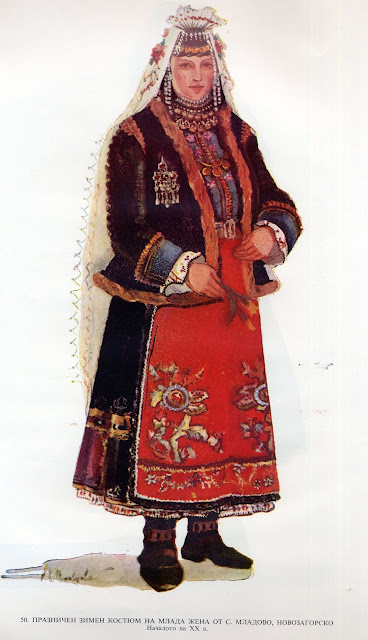Hello all,
Today I am going to talk about the costumes of the Bulgarian region of Thrace, or Trakiya. Thrace was originally a Greek word which referred a rather vague region which was north of Thessaly and east of Macedonia. They called the 'barbarian' tribes who lived there Thracians. We do not know what they called themselves. It is generally accepted that the Thracians contributed to the ethnogenesis of the Bulgarian people, together with Slavs and Bolgars. Today Thrace is generally considered to consist of the southeastern Balkans, including the European part of Turkey, northeastern Greece, and southeastern Bulgaria.
The Bulgarian cultural region of Thrace consists of the lowlands between the Balkan mountains on the north, the Rhodope mountains on the south, and the Black Sea on the east.
For the most part, the women's costume of Thrace is that of the Sukman, a black wool outer garment which pulls over the head. You can see these in the image at the head of the article; this is a group from around Elkhovo. In the south there are some regions which wear the saya, which is open down the front. Khaskovo is one example. There are also a few towns which developed their own sort of Town costume. These came out of the Bulgarian National revival of the early 20th cent. and show influence from both European and Turkish fashion. I will start with these.
Kotel
This town is in the north of Sliven oblast, not far from the borders of Shumen oblast, where they also have a couple of town costumes.
Koprivshtitsa
This town is in a peninsula-like eastern extension of Sofia oblast, but is part of the Thracian cultural region. It is best known for the pan Bulgarian folk festival which is held there every four years.
Panagiurishte
This town is in the north of Pazardzhik oblast, not very far from Koprivshtitsa.
Pazardzhik oblast
This is the westernmost part of Bulgarian Thrace. The southern tip of this oblast is really part of the Rhodope region.
These two are from the village of Buta. These are more modern style summer clothing.
These images are from the village of Varvara
Plovdiv Oblast
Rose harvester from around Karlovo
Summer work clothes from the village of Vasyl Levski near Karlovo.
Dəbene
Trivoditsi
Səedinenie
Milevo
In the southern part of Plovdiv province, they wear the saya costume, rather than the sukman.
Cheshnegirovo
Popovitsa
Here is a dance performance called 'Thracian Motifs'. It is performed in this costume, from Vinitsa near Prvomai.
https://www.youtube.com/watch?v=f2M8YtTPFck
Stara Zagora oblast
Again, in the north of Stara Zagora province, the sukman type costume is worn.
Vetren near Kazanluk
Trunkovo
Srnevo
Srnevo
In the south, especially around Chirpan, the saya type costume is worn.
Sliven oblast
Sliven oblast costumes have some similarities to those of Dobrudja, Varna, and the coastal regions. These include highly ornamented aprons, vests, and often the sukman is broken up into a bodice and skirt, sometimes sewn together, and sometimes separate.
Old costume from Kotel, in the northeast. Kotel later developed a town costume; see the beginning of the article.

Krushare
Seliminovo
These three are from around Novo Zagorsko, in the southwest
Video of a dance group based in Sliven
A youth group from Sliven performing in a dance festival in Poland
Burgas oblast
Karnobat in the northwest. The bridal costume was typified by the high headdress.
In the northeast, Pomorie region. These costumes are from Kozichino
This is the Lazarka costume from Kozichino or Erkech.
In the south, Strandzha region, although some consider Strandzha to include the entire coastal area up to Dobrich oblast.
In this area they sometimes layer up to three sukmans at a time.
This is the section of 'This is Bulgaria' which features Strandzha. It shows the Nestinari, the traditional fire-walkers of Bulgaria. It also plays out a drama involving a woman who is shunned by the community, her baby, and a man who is presumably the father. I admit to being unsure as to what exactly is going on. It also features some dancing and wrestling.
Yambol oblast
A part of a movie caled This is Bulgaria. This part features Thrace, specifically the region of Yambol. They start with Koledari, men singing carols, then they switch to spring.
Yambol, or Jambol, is in the north of this province.
These are from the district of Straldzha
These are from Zornitsa, which today is just over the border in Burgas oblast.
Here is the Bulgarian dance group Trakiya, this is an entire concert, but the first number is done in a costume from this area, followed by a dance from Pirin, a song from the Rhodoopes, A dance from Khaskovo, some singers in Karnobat costume, men dancing in southern Thracian costume, more songs and then Shope songs and dances with dancers in Sofia, Kjustendil, and Ikhtiman costumes and also military uniforms, another song, then a Thracian finale in Burgas costumes.
In the south is Elkhovo, where they use cross stitch embroidery around the front opening of the sukman in warm light colors. This is not found in the older costumes.
Khaskovo oblast
Parts of this province use the saya costume, being in the south of Bulgaria.
the southern extension is often considered to be part of the Rhodope region.
Dimitrovgrad
Topolovgrad
Kharmanli
Svilengrad
This is a bride from Lyubimets, here again we see elements of city costume.
A video of a group performing dances from Khaskovo region
A video of the Thracian Ruchenitsa
Thank you for reading, I hope that you have found this to be interesting and informative.
The culture of Thrace is as fascinating and interesting as that of the rest of Bulgaria.
Roman K
email:rkozakand@aol.com



















































































































